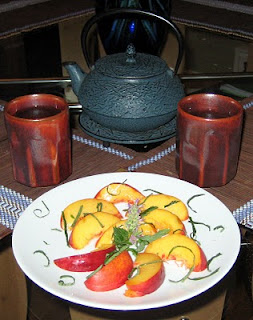Del Rio Botanical always sends a little insert describing what on earth they've sent you and some suggestions on what to do with it. This week, they recommended poaching the quail eggs and putting them on top of some cavern striped tomatoes (also in the produce box) stuffed with sushi rice. After careful calculation, I estimated that there was approximately one snowball's chance in a flying pig that I was going to be able to poach a quail egg with any sort of success, so instead, I just cracked them on top of the stuffed tomato and let them bake in the oven, which worked out pretty well.
Ingredients
4-6 cavern striped tomatoes (or other good stuffing tomato)
2/3 cups uncooked sushi rice (you could probably substitute Arborio rice, but the cooking time would be a little different)
Seasoned rice vinegar
1 cup cooked and chopped spinach (or 1 cup thawed frozen spinach, packed)
1 medium shallot, chopped
4-6 quail eggs
Combine the rice and a little over 3/4 cups water in a small pot, bring to a boil, turn down heat, and simmer for 15 minutes. Turn off the heat and sprinkle liberally with seasoned rice vinegar and stir to coat the grains. Adjust rice vinegar to taste (the rice will get diluted by other things, so make it definitely flavorful but not overly strong).
 Meanwhile, preheat oven to 400 degrees. Slice the top off each tomato and cut or scoop out the inside. Place on a foil-lined baking pan.
Meanwhile, preheat oven to 400 degrees. Slice the top off each tomato and cut or scoop out the inside. Place on a foil-lined baking pan.Saute the shallot with some olive oil in a fry pan over medium heat for a few minutes. Just as it begins to brown, add the spinach, stir a few times, and turn off the heat. Fold in the rice with a rice paddle.
If the tomatoes are pretty big, precook them in the oven for 5-7 minutes before stuffing.
Fill each tomato with the rice and spinach mixture, and then press your fingertip into the top of each mound of rice to make a slight indentation for the quail egg. Take a quail egg and crack it against the back of a knife (the trick is to do this firmly and fearlessly, but not so hard that you smash the egg into tiny pieces. They're stronger than you think, though, so give them a good whack to crack both the shell and the inner skin. If you're tentative, the shell gets very crumbly). Work a fingernail into the crack and gently peel back the top of the shell. Slide the egg out gently into the indentation you made in the rice-filled tomato, taking care not to break the yolk if possible. Repeat for each tomato.
 Slide the pan into the oven and bake for 7-10 minutes until whites become opaque. Serve on a bed of lightly dressed mixed baby greens.
Slide the pan into the oven and bake for 7-10 minutes until whites become opaque. Serve on a bed of lightly dressed mixed baby greens.Serves 2 for a light lunch.
















